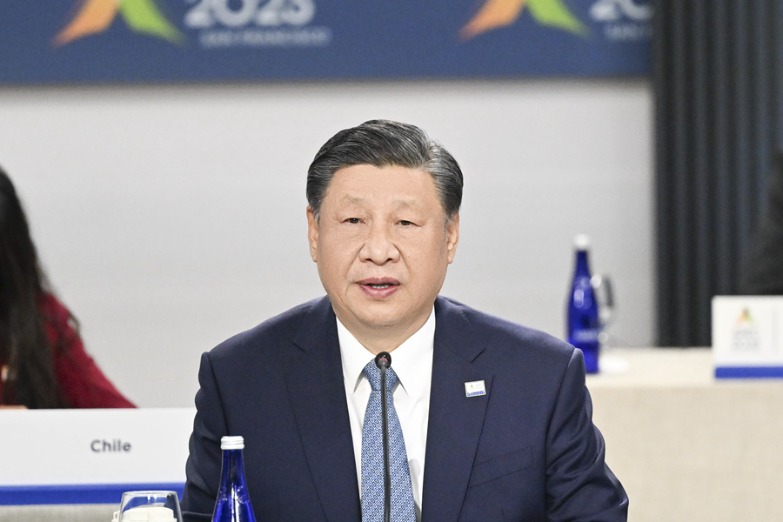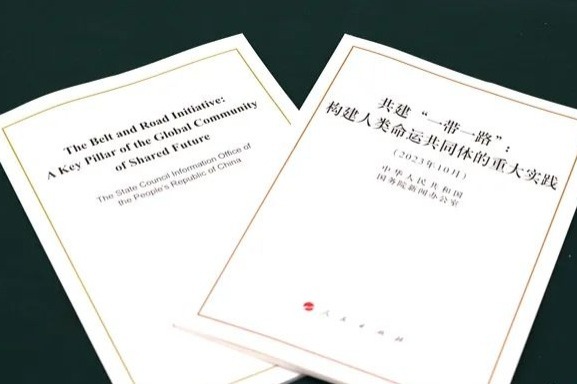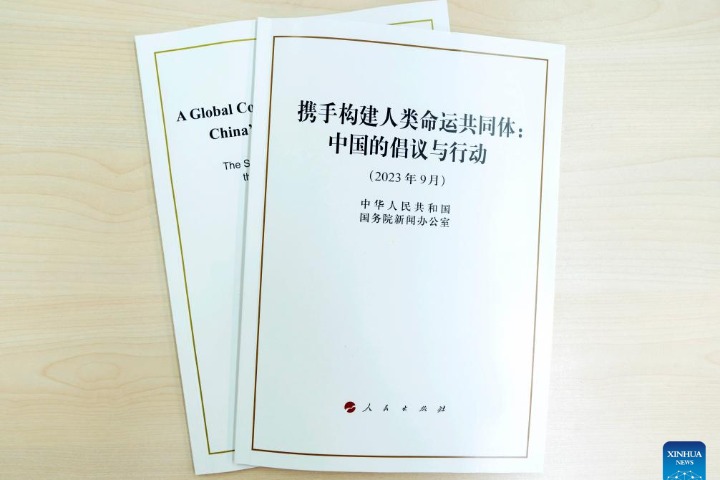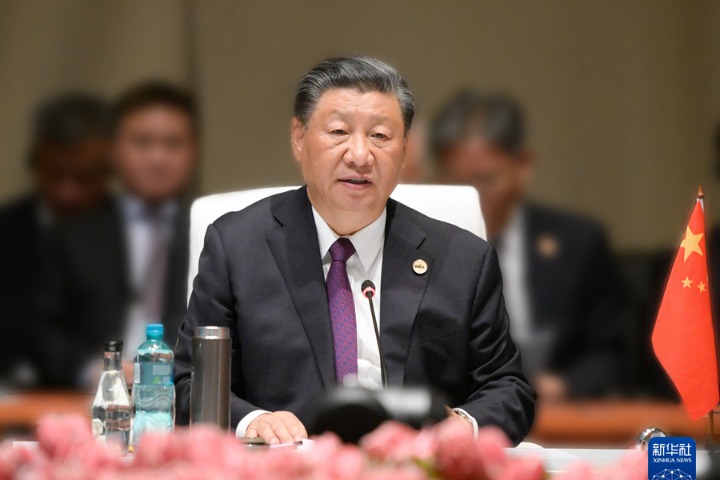共建“一带一路”倡议:进展、贡献与展望
新华网 2019-04-23 10:59

二、贡献
II. Contributions
共建“一带一路”倡议着眼于构建人类命运共同体,坚持共商共建共享原则,为推动全球治理体系变革和经济全球化作出了中国贡献。
With a view to building a global community of shared future, the Belt and Road Initiative upholds the principles of extensive consultation, joint contribution, and shared benefits. Through the initiative China has made a construc- tive contribution to the reform of the current global gover- nance system and to economic globalization.
(一)共商:从中国倡议到全球共识
1. Extensive consultation: from a Chinese proposal to a global consensus
共商就是“大家的事大家商量着办”,强调平等参与、充分协商,以平等自愿为基础,通过充分对话沟通找到认识的相通点、参与合作的交汇点、共同发展的着力点。
Extensive consultation means addressing issues that matter to all through consultation. On the basis of equality and free will, this principle emphasizes equal participation and full consultation in the process, so as to reach consen- sus in understanding, achieve convergence for cooperation, and develop a focus for common development.
——打造共商国际化平台与载体。2017年5月,首届“一带一路”国际合作高峰论坛在北京成功召开,29个国家的元首和政府首脑出席论坛,140多个国家和80多个国际组织的1600多名代表参会,论坛形成了5大类、76大项、279项具体成果,这些成果已全部得到落实。2019年4月,第二届“一带一路”国际合作高峰论坛继续在北京举办。“一带一路”国际合作高峰论坛已经成为各参与国家和国际组织深化交往、增进互信、密切往来的重要平台。2018年11月,首届中国国际进口博览会成功举办,172个国家、地区和国际组织参加,3600余家境外企业参展,4500多名政商学研各界嘉宾在虹桥国际经济论坛上对话交流,发出了“虹桥声音”。中国还举办了丝绸之路博览会暨中国东西部合作与投资贸易洽谈会、中国-东盟博览会、中国-亚欧博览会、中国-阿拉伯国家博览会、中国-南亚博览会、中国-东北亚博览会、中国西部国际博览会等大型展会,都成为中国与沿线各国共商合作的重要平台。
– Building international platforms for extensive consultation. In May 2017, the first Belt and Road Forum for International Cooperation held in Beijing was a great success. The event was attended by heads of state and gov- ernment of 29 countries as well as more than 1,600 repre- sentatives from over 140 countries and 80-plus international organizations. The forum produced 279 deliverables, in- volving 76 major items in five key areas. All these achieve- ments have now been implemented. The second Belt and Road Forum for International Cooperation will be held in Beijing in April 2019. The forum has become an important platform for participating countries and international or- ganizations, enabling more cooperation, closer ties, more exchanges, and enhanced mutual trust. In November 2018, the first China International Import Expo was held, attracting 172 countries, regions and international organizations and more than 3,600 enterprises from outside China. At the first Hongqiao International Economic Forum held at the expo, over 4,500 participants from governments, businesses, and academic and research institutions engaged in dialogue and exchanges and voiced their opinions. China has also hosted many large-scale expositions such as the Silk Road Interna- tional Exposition and the Investment and Trade Forum for Cooperation between East and West China, the China-ASEAN Expo, the China-Eurasia Expo, the China-Arab States Expo, the China-South Asia Expo, the China-Northeast Asia Expo, and the Western China International Fair. These events have become important platforms for consultation and coopera- tion between China and other B&R countries.
——强化多边机制在共商中的作用。共建“一带一路”顺应和平与发展的时代潮流,坚持平等协商、开放包容,促进沿线国家在既有国际机制基础上开展互利合作。中国充分利用二十国集团、亚太经合组织、上海合作组织、亚欧会议、亚洲合作对话、亚信会议、中国-东盟(10+1)、澜湄合作机制、大湄公河次区域经济合作、大图们倡议、中亚区域经济合作、中非合作论坛、中阿合作论坛、中拉论坛、中国-中东欧16+1合作机制、中国-太平洋岛国经济发展合作论坛、世界经济论坛、博鳌亚洲论坛等现有多边合作机制,在相互尊重、相互信任的基础上,积极同各国开展共建“一带一路”实质性对接与合作。
– Strengthening the role of multilateral mechanisms in extensive consultation. The concerted efforts to build the Belt and Road reflect the trends of the times – peace and development. Upholding the principles of consultation on an equal footing, openness, and inclusiveness, they aim to promote mutually beneficial cooperation among B&R countries on the basis of existing international mechanisms. Applying the principles of mutual respect and mutual trust, China actively engages in substantive coordination and cooperation on the Belt and Road Initiative with other par- ticipating countries, fully utilizing existing multilateral co- operation mechanisms such as:
• G20,
• APEC,
• Shanghai Cooperation Organization,
• Asia-Europe Meeting,
• Asia Cooperation Dialogue,
• Conference on Interaction and Confidence-Building Measures in Asia,
• China-ASEAN (10+1) cooperation mechanism,
• Lancang-Mekong cooperation mechanism,
• Greater Mekong Subregion Economic Cooperation,
• Greater Tumen Initiative,
• Central Asia Regional Economic Cooperation,
• Forum on China-Africa Cooperation,
• China-Arab States Cooperation Forum,
• China-CELAC Forum,
• China-CEEC “16+1 cooperation” mechanism,
• China-Pacific Island Countries Economic Develop- ment and Cooperation Forum,
• World Economic Forum,
• Boao Forum for Asia.
——建立“二轨”对话机制。中国与沿线国家通过政党、议会、智库、地方、民间、工商界、媒体、高校等“二轨”交往渠道,围绕共建“一带一路”开展形式多样的沟通、对话、交流、合作。中国组织召开了中国共产党与世界政党高层对话会,就共建“一带一路”相关议题深入交换意见。中国与相关国家先后组建了“一带一路”智库合作联盟、丝路国际智库网络、高校智库联盟等。英国、日本、韩国、新加坡、哈萨克斯坦等国都建立了“一带一路”研究机构,举办了形式多样的论坛和研讨会。中外高校合作设立了“一带一路”研究中心、合作发展学院、联合培训中心等,为共建“一带一路”培养国际化人才。中外媒体加强交流合作,通过举办媒体论坛、合作拍片、联合采访等形式,提高了共建“一带一路”的国际传播能力,让国际社会及时了解共建“一带一路”相关信息。
– Establishing a track two mechanism for dialogue. Through track two channels such as political parties, parlia- ments, think tanks, local authorities, NGOs, business commu- nities, the media, and institutions of higher learning, China and other B&R countries can engage in diverse communica- tion, dialogue, exchange, and cooperation, focusing on joint efforts to build the Belt and Road. China has organized the CPC in Dialogue with World Political Parties High-Level Meeting, during which the CPC had extensive communication with political parties from other countries on issues of the Belt and Road. China and other relevant countries have joint- ly established the Silk Road Think Tank Association, Silk Road Think Tank Network, and University Alliance of the Silk Road. The UK, Japan, Korea, Singapore, Kazakhstan and other countries have established research institutions on the Belt and Road and held a variety of forums and sympo- siums. Universities in China and other countries have jointly established research centers on the Belt and Road, schools for Belt and Road cooperation and development, and train- ing centers, with the aim of cultivating international talent to build the Belt and Road. Through means such as holding media forums, co-producing documentaries, and arranging joint interviews, Chinese and foreign media have strength- ened cooperation and exchange, improved their international communication capabilities, and helped the international community to access timely information on joint efforts to build the Belt and Road.
(二)共建:共同打造和谐家园
2. Joint contribution: joining forces to build a har- monious international community
共建就是各方都是平等的参与者、建设者和贡献者,也是责任和风险的共同担当者。
Joint contribution means that all the parties are equal participants, builders and contributors, and share responsi- bilities and risks.
——打造共建合作的融资平台。由中国发起的亚洲基础设施投资银行2016年开业以来,在国际多边开发体系中发挥越来越重要的作用,得到国际社会广泛信任和认可。截至2018年底,亚洲基础设施投资银行已从最初57个创始成员,发展到遍布各大洲的93个成员;累计批准贷款75亿美元,撬动其他投资近400亿美元,已批准的35个项目覆盖印度尼西亚、巴基斯坦、塔吉克斯坦、阿塞拜疆、阿曼、土耳其、埃及等13个国家。亚洲基础设施投资银行在履行自身宗旨使命的同时,也与其他多边开发银行一起,成为助力共建“一带一路”的重要多边平台之一。2014年11月,中国政府宣布出资400亿美元成立丝路基金,2017年5月,中国政府宣布向丝路基金增资1000亿人民币。截至2018年底,丝路基金协议投资金额约110亿美元,实际出资金额约77亿美元,并出资20亿美元设立中哈产能合作基金。2017年,中国建立“一带一路”PPP工作机制,与联合国欧洲经济委员会签署合作谅解备忘录,共同推动PPP模式更好运用于“一带一路”建设合作项目。
– Building financing platforms for cooperation. Since opening in 2016, the Asian Infrastructure Invest- ment Bank (AIIB), which was established in accordance with a proposal from China, has played a role of increasing importance in the international multilateral development system. It has won broad trust and recognition from the international community. As of the end of 2018, the mem- bership of AIIB had grown from the 57 founding members to 93, spread across five continents. It had approved loans of US$7.5 billion and leveraged other investments totaling almost US$40 billion. Its 35 approved projects are distrib- uted over 13 countries including Indonesia, Pakistan, Ta- jikistan, Azerbaijan, Oman, Turkey and Egypt. In fulfilling its own purposes and missions, the bank has become one of the key multilateral platforms for building the Belt and Road, along with other multilateral development banks. In November 2014 the Chinese government pledged US$40 billion to establish a Silk Road Fund, and in May 2017, it announced an additional RMB100 billion contribution to the fund. As of the end of 2018, the contracted investment under the fund had reached about US$11 billion, with ac- tual investment adding up to US$7.7 billion; the fund had also allocated US$2 billion to set up the China-Kazakhstan Industrial Capacity Cooperation Fund. In 2017, the Chi- nese government established the Public-Private-Partnership mechanism for the Belt and Road, and signed an MoU with the United Nations Economic Commission for Europe, to jointly promote better application of the mechanism in Belt and Road cooperation projects.
——积极开展第三方市场合作。共建“一带一路”致力于推动开放包容、务实有效的第三方市场合作,促进中国企业和各国企业优势互补,实现“1+1+1>3”的共赢。2018年,第一届中日第三方市场合作论坛和中法第三方市场合作指导委员会第二次会议成功举办。英国欣克利角核电等一批合作项目顺利落地,中国中车与德国西门子已经在一些重点项目上达成了三方合作共识。
– Actively conducting cooperation in third-party markets. In our efforts to build the Belt and Road, we are committed to promoting open, inclusive, pragmatic and effective cooperation in third-party markets, so as to help Chinese and foreign enterprises utilize their complemen- tary strengths and achieve a “1+1+1>3” all-win result in which the benefits of three-party cooperation are greater than what the parties can produce separately. In 2018 two successful forums were held: the first Forum on China- Japan Third-Party Market Cooperation and the second meeting of the Steering Committee for China-France Third-Party Cooperation. A batch of cooperation projects such as the Hinkley Point C nuclear power station in the UK were put into effect. China’s CRRC and Germany’s Siemens reached consensus on third-party cooperation in some key projects.
(三)共享:让所有参与方获得实实在在的好处
3. Shared benefits: ensuring all parties gain real benefits
共享就是兼顾合作方利益和关切,寻求利益契合点和合作最大公约数,使合作成果福及双方、惠泽各方。共建“一带一路”不是“你输我赢”或“你赢我输”的零和博弈,而是双赢、多赢、共赢。
Shared benefits mean that we take into consideration the interests and concerns of partners of cooperation, seek a convergence of interests with other countries, and expand common ground, so as to ensure that our cooperation is not only mutually beneficial but is beneficial to all parties. The Belt and Road Initiative is not a zero-sum game which results in the win of one party and the loss of the other. Rather, it is meant for mutual benefits and win-win and all-win outcomes.
——将发展成果惠及沿线国家。中国经济对世界经济增长的贡献率多年保持在30%左右。近年来,中国进口需求迅速扩大,在对国际贸易繁荣作出越来越大贡献的同时,拉动了对华出口的沿线国家经济增长。中国货物和服务贸易年进口值均占全球一成左右,2018年,中国货物贸易进口14.1万亿人民币,同比增长12.9%。2018年,中国对外直接投资1298.3亿美元,同比增长4.2%,对沿线国家的直接投资占比逐年增长。在共建“一带一路”合作框架下,中国支持亚洲、非洲、拉丁美洲等地区广大发展中国家加大基础设施建设力度,世界经济发展的红利不断输送到这些发展中国家。世界银行研究组的量化贸易模型结果显示,共建“一带一路”将使“发展中的东亚及太平洋国家”的国内生产总值平均增加2.6%至3.9%。(注3)
– Bringing China’s development achievements to other B&R countries. For several years now, China has accounted for about 30 percent of world economic growth. Through the rapid expansion of its demand for imports, China propels economic growth in the B&R countries that export goods to China. At the same time, China is making a growing contribution to international trade. China’s imports in goods and services both account for one tenth of the total global value. In 2018, China imported goods worth RMB14.1 trillion, up 12.9 percent from 2017. Its FDI to- taled US$129.83 billion, 4.2 percent higher than 2017, and the percentage of direct investment to other B&R coun- tries grew year by year. Under the cooperation framework of the Belt and Road Initiative, China supports developing countries such as those in Asia, Africa and Latin America to invest more in infrastructure. As a result, the benefits of world economic development are continuously brought to those countries. According to the quantitative trade model of a World Bank study, the Belt and Road Initiative will in- crease the GDP of East Asian and Pacific developing coun- tries by 2.6-3.9 percent on average.
——改善沿线国家民生。中国把向沿线国家提供减贫脱困、农业、教育、卫生、环保等领域的民生援助纳入共建“一带一路”范畴。中国开展了中非减贫惠民合作计划、东亚减贫合作示范等活动。积极实施湄公河应急补水,帮助沿河国家应对干旱灾害,向泰国、缅甸等国提供防洪技术援助。中国与世界卫生组织签署关于“一带一路”卫生领域合作的谅解备忘录,实施中非公共卫生合作计划、中国-东盟公共卫生人才培养百人计划等项目。中国累计与沿线国家合作培养数千名公共卫生管理和疾病防控人员,累计为相关国家5200余名白内障患者实施免费复明手术。中国每年为周边国家近3万名患者提供优质医疗服务。中国中医药团队先后在柬埔寨、科摩罗、多哥、圣多美和普林西比、巴布亚新几内亚等国家实施快速清除疟疾方案。
– Improving people’s wellbeing in other B&R countries. China includes the provision of aid in poverty reduction, agriculture, education, health, environmental protection and other areas into the joint efforts to build the Belt and Road. China has implemented the Program for China-Africa Cooperation on Poverty Reduction and Pub- lic Welfare, and pilot projects of the East Asia Coopera- tion Initiative on Poverty Reduction. It is actively helping countries in the basin of the Mekong River to tackle severe droughts by releasing emergency water supplies. It is also providing technological aid in flood control to Thailand and Myanmar. China signed an MoU with the WHO on health cooperation as part of the Belt and Road Initiative. It has also implemented a program for China-Africa public health cooperation and the China-ASEAN training programs for 100 public health professionals. China has trained sev- eral thousand professionals in public health management and disease prevention and control in cooperation with other B&R countries, and has offered free sight rehabilita- tion surgery to more than 5,200 cataract patients in those countries. Every year, China provides quality medical services to approximately 30,000 patients in neighboring countries. Chinese TCM teams have implemented plans for the rapid eradication of malaria in countries including Cambodia, Comoros, Togo, São Tomé and Príncipe, and Papua New Guinea.
——促进科技创新成果向沿线国家转移。中国与沿线国家签署了46个科技合作协定,先后启动了中国-东盟、中国-南亚等科技伙伴计划,与东盟、南亚、阿拉伯国家、中亚、中东欧共建了5个区域技术转移平台,发起成立了“一带一路”国际科学组织联盟。通过沿线国家青年科学家来华从事短期科研工作以及培训沿线国家科技和管理人员等方式,形成了多层次、多元化的科技人文交流机制。2018年,中国接收500名沿线国家青年科学家来华科研,培训科技管理人员逾1200人次。中国积极开展航天国际合作,推动中国北斗导航系统、卫星通讯系统和卫星气象遥感技术服务沿线国家建设。
– Facilitating the transfer of scientific and technologi- cal innovations to other B&R countries. China has signed 46 agreements on cooperation in science and technology with other B&R countries, and launched China-ASEAN and China-South Asia science and technology partnership pro- grams. It has built five regional platforms for technological transfer with ASEAN, South Asia, Arab States, Central Asia, and Central and Eastern Europe, and proposed and co- established the Alliance of International Science Organizations in the Belt and Road Region. A multi-level and diverse exchange mechanism in science and technology and hu- manities has been formed through various means, such as short terms of research in China by young scientists and the training of science and management personnel from other B&R countries. In 2018, China hosted 500 young scientists from such countries to carry out research, and trained more than 1,200 science and management professionals. China actively conducts cooperation with other B&R countries in space technology and makes its BeiDou Navigation Satel- lite System, satellite communication systems and satellite meteorological remote sensing technologies available to them.
——推动绿色发展。中国坚持《巴黎协定》,积极倡导并推动将绿色生态理念贯穿于共建“一带一路”倡议。中国与联合国环境规划署签署了关于建设绿色“一带一路”的谅解备忘录,与30多个沿线国家签署了生态环境保护的合作协议。建设绿色丝绸之路已成为落实联合国2030年可持续发展议程的重要路径,100多个来自相关国家和地区的合作伙伴共同成立“一带一路”绿色发展国际联盟。中国在2016年担任二十国集团主席国期间,首次把绿色金融议题引入二十国集团议程,成立绿色金融研究小组,发布《二十国集团绿色金融综合报告》。中国积极实施“绿色丝路使者计划”,已培训沿线国家2000人次。中国发布《关于推进绿色“一带一路”建设的指导意见》、《“一带一路”生态环境保护合作规划》等文件,推动落实共建“一带一路”的绿色责任和绿色标准。
– Promoting green development. Upholding the Paris Agreement, China actively advocates and encourages the integration of green development into the joint efforts to build the Belt and Road. China has signed an MoU on building green Belt and Road with the United Nations En- vironment Programme, and agreements on cooperation in ecological conservation with over 30 countries along the routes. Since building green Belt and Road has become an important means to implement the United Nations 2030 Agenda for Sustainable Development, more than 100 partners from the relevant countries and regions have estab- lished the International Coalition for Green Development on the Belt and Road. In 2016, under China’s presidency of the G20, green finance became a key agenda item for the first time. A Green Finance Study Group was set up, which released the “G20 Green Finance Synthesis Report”. China has actively implemented the Green Silk Road Envoys Program, and has trained 2,000 people from other B&R countries. It has issued documents such as “Guidance on Promoting Green Belt and Road” and the “Belt and Road Ecological and Environmental Cooperation Plan”, with the aim of fulfilling its responsibilities and standards in build- ing green Belt and Road.
(四)愿景:构建人类命运共同体
4. Vision: building a global community of shared future
共建“一带一路”顺应了人类追求美好未来的共同愿望。国际社会越来越认同共建“一带一路”倡议所主张的构建人类命运共同体的理念,构建人类命运共同体符合当代世界经济发展需要和人类文明进步的大方向。共建“一带一路”倡议正成为构建人类命运共同体的重要实践平台。
The joint efforts to build the Belt and Road reflect hu- manity’s common aspiration for a bright future. More and more members of the international community have identi- fied with the idea of building a global community of shared future advocated by the Belt and Road Initiative. The idea is in harmony with the need for world economic develop- ment and the direction of the progress of world civilization. The initiative is becoming an important platform for build- ing a global community of shared future.
——源自中国更属于世界。共建“一带一路”跨越不同地域、不同发展阶段、不同文明,是一个开放包容的平台,是各方共同打造的全球公共产品。共建“一带一路”目标指向人类共同的未来,坚持最大程度的非竞争性与非排他性,顺应了国际社会对全球治理体系公正性、平等性、开放性、包容性的追求,是中国为当今世界提供的重要公共产品。联合国秘书长古特雷斯指出,共建“一带一路”倡议与联合国新千年计划宏观目标相同,都是向世界提供的公共产品。共建“一带一路”不仅促进贸易往来和人员交流,而且增进各国之间的了解,减少文化障碍,最终实现和平、和谐与繁荣。
– Proposed by China but belonging to the whole world. The Belt and Road covers different regions at dif- ferent stages of development that have different cultures. It is an open and inclusive platform and a global public prod- uct forged by all parties involved. Directed toward a shared future for humanity, the Belt and Road Initiative upholds its noncompetitive and nonexclusive nature to the fullest ex- tent. It reflects the international community’s demand for a global governance system that is fair, egalitarian, open and inclusive. It is an important public product oriented toward today’s world. As UN Secretary-General António Guterres has pointed out, the Belt and Road Initiative and the United Nation’s Millennium Development Goals share the same grand goals, and both are public goods offered to the world. The Belt and Road Initiative not only promotes internation- al trade and people-to-people exchanges, but also enhances understanding between countries and reduces cultural bar- riers, to ultimately achieve peace, harmony and prosperity.
——为全球治理体系变革提供了中国方案。当今世界面临增长动能不足、治理体系滞后和发展失衡等挑战。共建“一带一路”体现开放包容、共同发展的鲜明导向,超越社会制度和文化差异,尊重文明多样性,坚持多元文化共存,强调不同经济发展水平国家的优势互补和互利共赢,着力改善发展条件、创造发展机会、增强发展动力、共享发展成果,推动实现全球治理、全球安全、全球发展联动,致力于解决长期以来单一治理成效不彰的困扰。
– Offering a Chinese approach to reforming the current global governance system. Our world today faces challenges such as an insufficient drive for growth, an out-dated governance structure, and imbalanced development. Being open and inclusive and aiming for common develop- ment, the Belt and Road Initiative transcends differences in social systems and cultures, respects the diversity of world civilization and the coexistence of diverse cultures, and emphasizes mutual complementarity and mutual benefit among countries at different levels of economic develop- ment. It focuses on improving conditions and creating op- portunities for development, strengthening the drive for development, and sharing the fruits of development. It propels the interaction between global governance, secu- rity, and development – an attempt to provide an alternative solution to these issues as they have not been addressed ef- fectively in isolation over long periods of time.
——把沿线国家的前途和命运紧紧联系在一起。人类只有一个地球,各国共处一个世界。为了应对人类共同面临的各种挑战,追求世界和平繁荣发展的美好未来,世界各国应风雨同舟,荣辱与共,构建持久和平、普遍安全、共同繁荣、开放包容、清洁美丽的世界。人类命运共同体理念融入了利益共生、情感共鸣、价值共识、责任共担、发展共赢等内涵。共建“一带一路”主张守望相助、讲平等、重感情,坚持求同存异、包容互谅、沟通对话、平等交往,把别人发展看成自己机遇,推进中国同沿线各国乃至世界发展机遇相结合,实现发展成果惠及合作双方、各方。中国在40年改革开放中积累了很多可资借鉴的经验,中国无意输出意识形态和发展模式,但中国愿意通过共建“一带一路”与其他国家分享自己的发展经验,与沿线国家共建美好未来。
–Binding together B&R countries to share a common future. We have only one earth, and all countries share the same planet. To meet the various challenges faced by humanity and work for a bright future in which the whole world enjoys peace, prosperity and development, countries across the globe should share the rough times and the smooth and build an open, inclusive, clean, and beautiful world that enjoys lasting peace, common security, and shared prosper- ity. The concept of a global community of shared future involves combining interests, seeking common feelings, values, and responsibilities, and sharing the benefits of de- velopment. The Belt and Road Initiative calls for mutual support and assistance and is informed by equality, cultural affinity, and empathy. It upholds the principles of seeking common ground while reserving differences, inclusive- ness, mutual understanding, communication and dialogue, and interactions on an equal footing. We should regard the development of other countries as our own opportunity and promote the convergence of China’s development oppor- tunities with those of its B&R partners and other countries in the wider world, so as to ensure that our development benefits both sides of cooperation and all relevant parties. During its four decades of reform and opening up, China has accumulated a wealth of experience that can be used by other countries. It has no desire to export its ideology and no intention to impose its development model on other countries. It is willing to share its experience with other countries and create a bright future together with its B&R partners under the B&R framework.

















 英语点津微信
英语点津微信 双语小程序
双语小程序